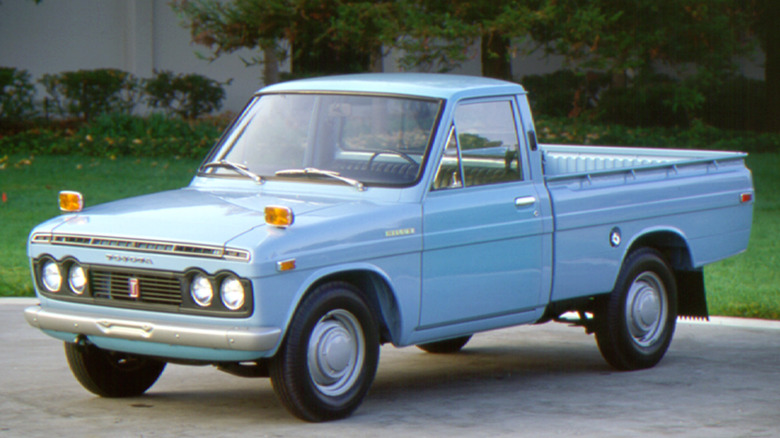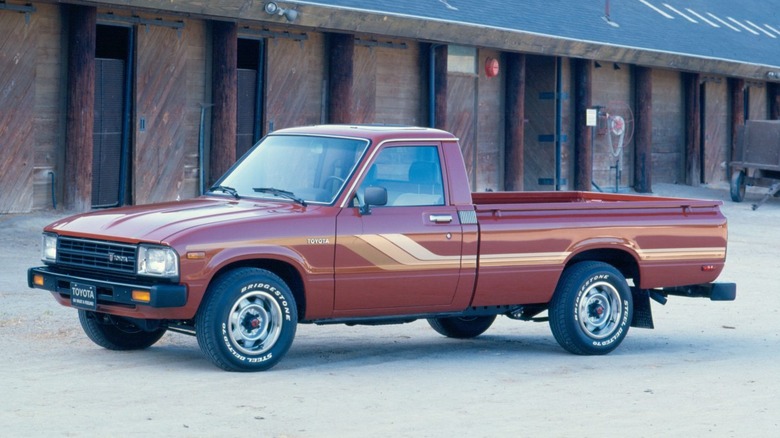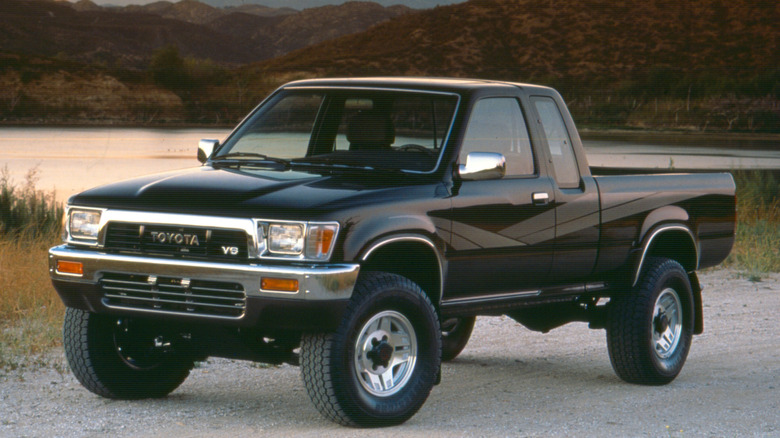Every Big Way The Toyota Hilux Has Changed In The U.S. Over The Years
According to Toyota, the name Hilux is a portmanteau of the words "high" and "luxury." While definitely not luxurious by modern standards, the Hilux was arguably plusher than Toyota's Briska and Light Stout, the trucks that it replaced when it debuted in 1968. The first-generation Hilux was designed by Toyota, but production was outsourced to another Japanese manufacturer — Hino Motors.
Although a few different configurations of the Hilux were available globally, the U.S. market initially only got a standard cab with a short (six-foot) cargo bed. All of the little trucks were rear-wheel drive only with a column-shifted four-speed manual transmission.
The second-generation Hilux that was introduced for the 1973 model year wasn't significantly different from the outgoing truck but for slightly updated styling and an optional floor shifter for the four-speed manual transmission, a move that necessitated a pair of modern bucket seats instead of a full-width bench seat. For the first time ever, an automatic transmission was also offered with select trim levels.
As the 1970s wore on, the second-generation Hilux started to self-fulfill its name, especially in the American market. A larger 2.2-liter engine was introduced, as well as upscale trims like the SR5, and even a five-speed manual transmission with an overdrive gear for highway cruising. It was also during this time that Toyota started to market the Hilux to American buyers as simply the "Toyota Truck" or "Pickup," a trend that would endure until the mid-1990s.
Four-wheel drive makes an appearance
The all-new third-generation HiLux for 1979 is where Toyota's truck really started to embrace its current persona as a vehicle for not only construction trades or farmers but also adventure seekers and outdoor enthusiasts. Perhaps the biggest contribution toward that goal was a newly available four-wheel drive system.
Other parts of the world received a double cab (crew cab) configuration but the U.S. market was limited to a standard cab with two different bed length options. The third-gen Hilux would also introduce the 2.4-liter inline-four-cylinder engine, called the 22R. The 22R would develop a reputation for reliability and durability, traits that would extend to the truck itself.
The new fourth-generation Hilux was perhaps the most successful yet — over 1.5 million units were sold in North America alone between 1984 and 1988. This generation truck introduced Toyota's Xtracab, a six-inch extension to the passenger cabin which provided additional dry, secure storage behind the front seats.
The fourth-gen also debuted independent front suspension for the four-wheel drive model, as well an optional V6 engine, both in 1986. A black four-wheel drive Hilux with some aftermarket accessories made a short-but-memorable appearance as Marty McFly's ride in the 1985 film "Back to the Future."
The Hilux and Tacoma part company
An all-new fifth-generation Hilux was released for the 1989 model year, once again with an available Xtracab, but one that was even larger than the previous generation — large enough to squeeze a pair of compact rear seats in the space. To propel the additional mass, the 3.0 liter V6 that was available in the prior generation became more commonplace.
Motor Trend picked a V6-powered Hilux SR5 for its Truck of the Year in 1989, extolling the praise that, "This vehicle is at once more car-like and performance-orientated than some sport coupes, and its styling and versatility offer much more than standard sport coupe fare."
In 1995, Toyota decided to bring an all-new design to the American market, one which was larger and more comfort-oriented. That new truck was called Tacoma and for the first time, the Hilux and the compact truck for the American market were two completely different animals. The Hilux is still available in other parts of the world with major redesigns happening in 1997, 2004, and 2015.
To get a sense of just how much compact pickups have grown over the years, Motor Trend compared a third-gen Hilux from 1980 versus a 2020 Tacoma Crew Cab with a short (five-foot) cargo bed. The Tacoma weighed in at a whopping 1,535 pounds more than the classic Hilux. The Tacoma also measured nearly 12 inches wider and an almost unbelievable 43 inches longer overall.


